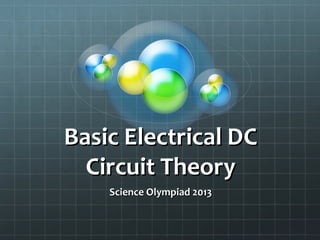
Basic dc circuit theory
- 1. Basic Electrical DC Circuit Theory Science Olympiad 2013
- 2. It all starts with the ATOM An ATOM is composed of three parts: PROTONS NEUTRONS ELECTRONS The tightly – bound clump of protons & neutrons in the center of the ATOM is called the nucleus THE ELEMENT OF CARBON
- 3. PROTONS = IDENTITY The tightly – bound clump of protons & neutrons in the center of the ATOM is called the nucleus. The number of protons in the nucleus is what determines its elemental identity; in this case CARBON. THE ELEMENT OF CARBON
- 4. NEUTRONS = MASS If neutrons are added or gained in the nucleus the ATOM will retain the same chemical identity, but its MASS will change slightly and it may acquire strange nuclear properties such as radioactivity
- 5. ELECTRONS = ATTRACTION Electrons, unlike protons and neutrons, have more freedom to move around. In fact they can be knocked out of position and leave an ATOM entirely; if that happens the ATOM keeps its chemical identity but a very important imbalance happens. electrons & protons are unique because they are attracted to one another over a distance. It is this attraction over distance which causes the attraction between rubbed objects, where electrons are moved away from their original atoms to reside around atoms of THE ELEMENT OF another object. CARBON
- 6. POSITIVE & NEGATIVE CHARGES ELECTRONS (-) PROTONS (+) Have a NEGATIVE Have a POSITIVE charge charge An object whose An object whose atoms have atoms are lacking received a surplus electrons is of electrons is positively charged negatively charged THE ELEMENT OF CARBON In equal numbers within an atom, they counteract each other's presence so that the net charge within the atom is zero. This is why the picture of a carbon atom has six electrons: to balance out the electric charge of the six protons in the nucleus. If electrons leave or extra electrons arrive, the atom's net electric charge will be imbalanced, leaving the atom "charged" as a whole, causing it to interact with charged particles and other charged atoms nearby. Neutrons are neither attracted to or repelled by electrons, protons, or even other neutrons, and are consequently categorized as having no charge at all.
- 7. What is A Circuit? Electrons flow from the zinc casing to the carbon rod, lighting the bulb in the process. The zinc casing acts as a negative electrode; the carbon rod acts as a positive electrode. The ammonium chloride paste acts as the electrolyte and the carbon and the manganese dioxide mixture around the carbon rod extends the battery's life. Let's take an example of a battery, for now. The battery has a positive (+) end, and a minus ( - ) end. When you touch a wire onto both ends of the battery at the same time, you have created a circuit. What just happened? Current flowed from one end of the battery to the other through your wire. Therefore, our definition of circuit can simply be a never-ending looped pathway for electrons (the battery counts as a pathway!).
- 8. Requirements for a Circuit Must have a closed conducting path which extends from the positive terminal to the negative terminal. Think of this as a circle or a loop ALL connections must be made by conducting materials capable of carrying charge.
- 9. Current This battery takes these negatively charged electrons from a chemical reaction inside the battery, pushes them out of the negative end of the battery, and into the wire. These electrons will then bump electrons in the atoms of the wire over and over until finally electrons arrive back at the positive end of the battery. Elements which allow this process of "bumping" those electrons on over determines how conductive the element is. So, when there's a current, it's just electrons bumping each other from atom to atom and flowing on.